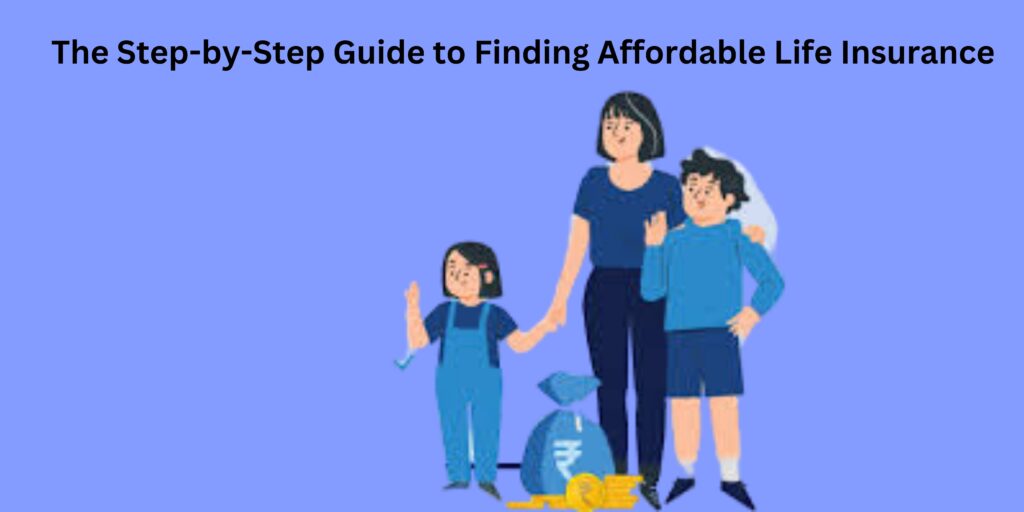Life insurance is one of the most important financial safety nets you can have, but many people avoid it because they think it’s too expensive. The truth is, with the right approach, you can find an affordable life insurance policy that fits your needs. In this guide, we will break down everything you need to know to secure an affordable life insurance plan while ensuring maximum benefits.

Why Do You Need Life Insurance?
Before jumping into how to find affordable life insurance, it’s crucial to understand why it matters:
- Financial Security for Your Family: Protect your loved ones from financial hardships if something happens to you.
- Debt Coverage: Ensures that outstanding loans, such as home or car loans, do not burden your family.
- Income Replacement: Helps maintain your family’s standard of living.
- Education Fund for Children: Provides financial support for your children’s education.
- Peace of Mind: Knowing your family is financially protected gives you a sense of security.
Step-by-Step Guide to Finding Affordable Life Insurance
Step 1: Determine Your Coverage Needs
To get the best life insurance policy at an affordable price, you first need to assess your coverage needs. Consider factors like:
- Your current and future financial obligations
- Outstanding debts (mortgage, loans, credit cards)
- Your children’s education costs
- Your family’s living expenses
- Any other dependents who rely on you financially
Step 2: Choose the Right Type of Life Insurance
There are two main types of life insurance policies:
1. Term Life Insurance
- Affordable option with lower premiums
- Provides coverage for a fixed term (10, 20, or 30 years)
- No cash value, only a death benefit
- Ideal for those looking for temporary coverage at low costs
2. Whole Life Insurance
- Covers you for your entire life
- More expensive but includes an investment component (cash value)
- Suitable for those looking for lifelong coverage and an investment opportunity
Tip: If affordability is your main concern, go for term life insurance, as it provides the necessary coverage at a lower cost.
Read more
Step 3: Compare Multiple Insurance Providers
Not all insurance providers offer the same rates. To find the best deal:
- Get quotes from at least 3-5 different insurers
- Use online comparison tools to compare rates easily
- Check customer reviews to ensure the company has a good reputation
- Look at financial stability ratings to make sure the insurer will be around when needed
Step 4: Improve Your Health and Lifestyle
Insurance premiums are directly affected by your health and lifestyle choices. Here’s how you can reduce costs:
- Quit smoking: Smokers pay significantly higher premiums.
- Maintain a healthy weight: Obesity increases health risks, leading to higher premiums.
- Exercise regularly: A healthy lifestyle can help you qualify for better rates.
- Manage pre-existing conditions: Controlling conditions like diabetes or high blood pressure can lower your premiums.
- Avoid risky hobbies: Activities like skydiving, scuba diving, or racing can increase costs.
Step 5: Buy Life Insurance at the Right Age
Life insurance premiums increase with age. The younger and healthier you are when you buy a policy, the lower your premiums will be. Ideally, purchase life insurance in your 20s or 30s to lock in the best rates.
Step 6: Opt for a Longer Policy Term Early On
When buying term insurance, selecting a longer-term policy (e.g., 30 years instead of 10) can save money in the long run. Renewing a policy later in life comes with higher premiums.
Step 7: Avoid Unnecessary Riders
Insurance riders are add-ons that increase your premium. While some are beneficial, others may not be necessary. Only consider:
- Accidental Death Benefit Rider (if you have a high-risk job)
- Waiver of Premium Rider (if you want to keep coverage even after disability)
- Critical Illness Rider (if you’re concerned about major illnesses)
Avoid unnecessary add-ons to keep costs low.
Step 8: Choose Annual Payments Instead of Monthly
Paying your premium annually instead of monthly often comes with discounts. If your budget allows, opt for annual payments to reduce overall costs.
Step 9: Take Advantage of Employer-Sponsored Life Insurance
Many employers offer group life insurance at discounted rates. While these policies are not always sufficient, they can supplement your individual policy at a lower cost.
Step 10: Work with an Independent Insurance Agent
An independent agent can:
- Compare multiple policies from different insurers
- Help find discounts and deals
- Provide unbiased advice on coverage
This can save you time and money while ensuring you get the best policy for your needs.
FAQs About Finding Affordable Life Insurance
Term life insurance is the most affordable option, as it only provides a death benefit without an investment component.
A general rule is to have a policy worth 10-15 times your annual income, but it depends on your financial obligations.
Yes, but your premiums might be higher. Managing your condition well can help lower the rates.
Maintain a healthy lifestyle
Choose term insurance
Compare multiple providers
Buy insurance at a younger age
Avoid unnecessary riders
Buying online is faster and may offer lower rates, but an independent agent can help you navigate options and find the best deal.
Conclusion
Finding affordable life insurance doesn’t have to be complicated. By determining your needs, choosing the right policy, improving your health, and comparing multiple providers, you can secure a cost-effective plan that ensures your family’s financial future. Start your search today and enjoy the peace of mind that comes with knowing your loved ones are protected.
